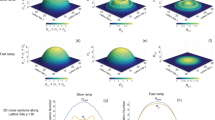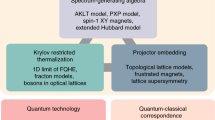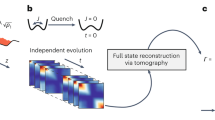Abstract
On the fundamental level, quantum fluctuations or entanglement lead to complex dynamical behaviour in many-body systems1 for which a description as emergent phenomena can be found within the framework of quantum field theory. A central quantity in these efforts, containing all information about the measurable physical properties, is the quantum effective action2. Though non-equilibrium quantum dynamics can be exactly formulated in terms of the quantum effective action, finding solutions is in general beyond the capabilities of classical computers3. Here, we present a strategy to determine the non-equilibrium quantum effective action4 using analogue quantum simulators, and demonstrate our method experimentally with a quasi-one-dimensional spinor Bose gas out of equilibrium5,6. Spatially resolved snapshots of the complex-valued transversal spin field7 allow us to infer the quantum effective action up to fourth order in an expansion in one-particle irreducible correlation functions at equal times. We uncover a strong suppression of the irreducible four vertex emerging at low momenta in the highly occupied regime far from equilibrium where perturbative descriptions fail8. Our work constitutes a new realm of large-scale analogue quantum computing9, where highly controlled synthetic quantum systems10 provide the means for solving theoretical problems in high-energy and condensed-matter physics with an experimental approach11,12,13,14.
This is a preview of subscription content, access via your institution
Access options
Access Nature and 54 other Nature Portfolio journals
Get Nature+, our best-value online-access subscription
$29.99 / 30 days
cancel any time
Subscribe to this journal
Receive 12 print issues and online access
$209.00 per year
only $17.42 per issue
Buy this article
- Purchase on Springer Link
- Instant access to full article PDF
Prices may be subject to local taxes which are calculated during checkout




Similar content being viewed by others
Data availability
Source data and all other data that support the plots within this paper and other findings of this study are available from the corresponding author upon reasonable request.
Change history
15 February 2021
A Correction to this paper has been published: https://doi.org/10.1038/s41567-020-1024-4
References
Polkovnikov, A., Sengupta, K., Silva, A. & Vengalattore, M. Colloquium: nonequilibrium dynamics of closed interacting quantum systems. Rev. Mod. Phys. 83, 863–883 (2011).
Weinberg, S.The Quantum Theory of Fields (Cambridge Univ. Press, 1995).
Jordan, S. P., Lee, K. S. & Preskill, J. Quantum algorithms for quantum field theories. Science 336, 1130–1133 (2012).
Wetterich, C. Nonequilibrium time evolution in quantum field theory. Phys. Rev. E 56, 2687-2690 (1997).
Sadler, L., Higbie, J., Leslie, S., Vengalattore, M. & Stamper-Kurn, D. Spontaneous symmetry breaking in a quenched ferromagnetic spinor Bose–Einstein condensate. Nature 443, 312–315 (2006).
Stamper-Kurn, D. M. & Ueda, M. Spinor Bose gases: symmetries, magnetism, and quantum dynamics. Rev. Mod. Phys. 85, 1191–1244 (2013).
Kunkel, P. et al. Simultaneous readout of noncommuting collective spin observables beyond the standard quantum limit. Phys. Rev. Lett. 123, 063603 (2019).
Pitaevskii, L. & Lifshitz, E. Physical Kinetics Vol. 10 (Butterworth-Heinemann, 2012).
Horsman, C., Stepney, S., Wagner, R. C. & Kendon, V. When does a physical system compute? Proc. R. Soc. A 470, 20140182 (2014).
Bloch, I., Dalibard, J. & Nascimbène, S. Quantum simulations with ultracold quantum gases. Nat. Phys. 8, 267–276 (2012).
Zohar, E., Cirac, J. I. & Reznik, B. Quantum simulations of lattice gauge theories using ultracold atoms in optical lattices. Rep. Prog. Phys. 79, 014401 (2015).
Lewenstein, M. et al. Ultracold atomic gases in optical lattices: mimicking condensed matter physics and beyond. Adv. Phys. 56, 243–379 (2007).
Loh, E. Jr et al. Sign problem in the numerical simulation of many-electron systems. Phys. Rev. B 41, 9301 (1990).
Troyer, M. & Wiese, U.-J. Computational complexity and fundamental limitations to fermionic quantum Monte Carlo simulations. Phys. Rev. Lett. 94, 170201 (2005).
Wilson, K. G. The renormalization group: critical phenomena and the kondo problem. Rev. Mod. Phys. 47, 773–840 (1975).
Zache, T. V., Schweigler, T., Erne, S., Schmiedmayer, J. & Berges, J. Extracting the field theory description of a quantum many-body system from experimental data. Phys. Rev. X 10, 011020 (2020).
Schweigler, T. et al. Experimental characterization of a quantum many-body system via higher-order correlations. Nature 545, 323–326 (2017).
Hodgman, S. S., Khakimov, R. I., Lewis-Swan, R. J., Truscott, A. G. & Kheruntsyan, K. V. Solving the quantum many-body problem via correlations measured with a momentum microscope. Phys. Rev. Lett. 118, 240402 (2017).
Rispoli, M. et al. Quantum critical behaviour at the many-body localization transition. Nature 573, 385–389 (2019).
Preiss, P. M. et al. High-contrast interference of ultracold fermions. Phys. Rev. Lett. 122, 143602 (2019).
Prüfer, M. et al. Observation of universal dynamics in a spinor Bose gas far from equilibrium. Nature 563, 217–220 (2018).
Gerbier, F., Widera, A., Fölling, S., Mandel, O. & Bloch, I. Resonant control of spin dynamics in ultracold quantum gases by microwave dressing. Phys. Rev. A 73, 041602(R) (2006).
Kawagushi, Y. & Ueda, M. Spinor Bose–Einstein condensates. Phys. Rep. 520, 253–381 (2012).
Hillery, M., O’Connell, R. F., Scully, M. O. & Wigner, E. P. Distribution functions in physics: fundamentals. Phys. Rep. 106, 121–167 (1984).
Erne, S., Bücker, R., Gasenzer, T., Berges, J. & Schmiedmayer, J. Universal dynamics in an isolated one-dimensional Bose gas far from equilibrium. Nature 563, 225–229 (2018).
Berges, J., Rothkopf, A. & Schmidt, J. Nonthermal fixed points: effective weak coupling for strongly correlated systems far from equilibrium. Phys. Rev. Lett. 101, 041603 (2008).
Orioli, A. P., Boguslavski, K. & Berges, J. Universal self-similar dynamics of relativistic and nonrelativistic field theories near nonthermal fixed points. Phys. Rev. D 92, 025041 (2015).
Walz, R., Boguslavski, K. & Berges, J. Large-N kinetic theory for highly occupied systems. Phys. Rev. D 97, 116011 (2018).
Chantesana, I., Orioli, A. P. & Gasenzer, T. Kinetic theory of nonthermal fixed points in a Bose gas. Phys. Rev. A 99, 043620 (2019).
Prüfer, M. Experimentally testing quantum field theory concepts with spinor Bose gases far from equilibrium. PhD thesis, Univ. Heidelberg (2020).
Domino, K., Gawron, P. & Pawela, Ł. Efficient computation of higher-order cumulant tensors. SIAM J. Sci. Comput. 40, A1590–A1610 (2018).
Acknowledgements
This Letter comprises parts of the doctoral thesis work of M.P.30 and T.V.Z., submitted to Heidelberg University, Germany. We thank S. Erne, T. Gasenzer, P. Hauke, C.-M. Schmied, J. Schmiedmayer, T. Schweigler and M. Tarpin for discussions and R. Rosa-Medina for experimental assistance. This work was supported by the DFG Collaborative Research Center SFB1225 (ISOQUANT) and the ERC Advanced Grant Horizon 2020 EntangleGen (project ID 694561), by Deutsche Forschungsgemeinschaft (DFG) under Germany’s Excellence Strategy EXC-2181/1 - 390900948 (the Heidelberg STRUCTURES Excellence Cluster) and the Heidelberg Center for Quantum Dynamics. P.K. acknowledges support from the Studienstiftung des deutschen Volkes.
Author information
Authors and Affiliations
Contributions
The experimental and theoretical concept was developed in discussion among all authors. M.P., P.K., S.L. and A.B. controlled the experimental apparatus. M.P. and T.V.Z. analysed the data. M.P., T.V.Z., P.K., H.S., J.B. and M.K.O. discussed the measurement results. T.V.Z. and J.B. elaborated the equal-time formalism. All authors contributed to the discussion of the results and the writing of the manuscript.
Corresponding author
Ethics declarations
Competing interests
The authors declare no competing interests.
Additional information
Publisher’s note Springer Nature remains neutral with regard to jurisdictional claims in published maps and institutional affiliations.
Extended data
Extended Data Fig. 2 1PI four vertex.
\({\varGamma }_{t}^{(4)}({p}_{1},{p}_{2},{p}_{3},{p}_{4})\) inferred from the data for the same momenta as shown in Fig. 2c. For comparison we show the results for the Gaussian model.
Extended Data Fig. 3 Momentum conserving diagonals.
Momentum conserving diagonals of the four-point 1PI correlators shown in Fig. 3 for all evolution times between 9 s and 18 s. Grey shaded area is the finite statistical bias from a Gaussian model. All error bars shown are 1 s.d. calculated from bootstrap resampling.
Extended Data Fig. 4 Universal dynamics of two-point correlator.
a, Time evolution of two-point correlator for longest times accessible in the experiment. b, A rescaling analysis yields α = β = 0.45 ± 0.05. After rescaling the data collapses on a universal curve. The found dynamics underlines the universal features found in these and previous experiments.
Extended Data Fig. 5 Rescaling of different momentum conserving diagonals.
Momentum conserving diagonals of the 1PI four-point correlator shown in Fig. 3 for all evolution times between 9 s and 18 s rescaled as in Fig. 4b with γ = 0 and β4 = 1/2. Given the finite statistics, we attribute the quality of the scaling collapse shown in Fig. 4b (compared to the shifted momentum diagonals shown here) to a larger signal-to-noise ratio, which is also evidenced by smaller statistical errors. All error bars shown are 1 s.d. calculated from bootstrap resampling.
Rights and permissions
About this article
Cite this article
Prüfer, M., Zache, T.V., Kunkel, P. et al. Experimental extraction of the quantum effective action for a non-equilibrium many-body system. Nat. Phys. 16, 1012–1016 (2020). https://doi.org/10.1038/s41567-020-0933-6
Received:
Accepted:
Published:
Issue Date:
DOI: https://doi.org/10.1038/s41567-020-0933-6
This article is cited by
-
Witnessing light-driven entanglement using time-resolved resonant inelastic X-ray scattering
Nature Communications (2023)
-
Condensation and thermalization of an easy-plane ferromagnet in a spinor Bose gas
Nature Physics (2022)
-
Oscillating scalar dissipating in a medium
Journal of High Energy Physics (2021)



